At-a-glance: The emergence of nitazenes and brorphine in Canada since 2019
On this page
- Executive summary
- Context
- Goal and focus
- Methods
- Number and proportion of exhibits analyzed between 2019 and 2021
- Geographic distribution and trafficking routes
- Characteristics of exhibits seized and analyzed
- Conclusion
- Acknowledgements
- Suggested Citation
- References
Executive summary
- Isotonitazene is the most frequently detected Nitazene/Brorphine in Canada, representing 46.8% of all Nitazene/Brorphine detections.
- The number of detections peaked in fall of 2020 with an increase in Etodesnitazene detections, and again in spring of 2021 with increased Protonitazene detections.
- Protonitazene emerged in late 2020 and constituted a quarter of Nitazene/Brorphine detections in 2021.
- Detections were most often reported from Ontario (43.5%) and Quebec (38.5%).
- While Protonitazene was only detected in the east (Quebec, New Brunswick and Ontario), Brorphine was only detected in the west (Alberta, British Columbia and Saskatchewan).
- Brorphine, Etodesnitazene and Metonitazene were mainly detected in powder form while Isotonitazene and Protonitazene were most frequently found in tablet form.
Context
Nitazenes and Brorphine are classified as opioids and belong to the benzimidazole chemical group. The first Nitazene/Brorphine seized and analyzed in Canada was Isotonitazene. It was seized in Quebec City by the local police service and received by the Drug Analysis Service (DAS) in May 2019 (Table 1). Since then, the DAS analyzed several substances belonging to this group including Brorphine, Etodesnitazene, Flunitazene, Metonitazene and Protonitazene (Table 1). Chemical substances in this group continue to emerge and it is now posited that Nitazenes and Brorphine will take an important place in the market of illegal substances in the coming yearsFootnote 1. Several substances belonging to this group have not been analyzed in Canada but have been reported elsewhere. For example, Butonitazene, which has been found in the US, has not yet been detected in CanadaFootnote 2.
Figure 1: Canada’s map of provinces and territories
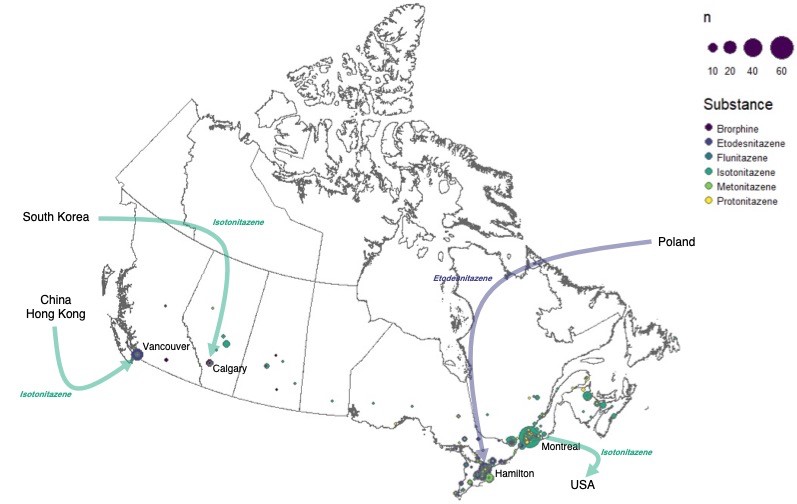
Figure 1 - Text description
This figure shows a map of Canada, indicating distribution of Brorphine, Etodesnitazene, Flunitazene, Isotonitazene, Metonitazene and Protonitazene across provinces.
Arrows indicate the hypothetical drug geographic distribution and trafficking routes. Isotonitazene is being imported into Canada via airfare from China, Hong Kong and South Korea and that Etodesnitazene is being imported from Poland. Isotonitazene has also been found to be exported from Canada to the United States via mail.
| Province | Brorphine | Etodesnitazene | Flunitazene | Isotonitazene | Metonitazene | Protonitazene | ||||||
|---|---|---|---|---|---|---|---|---|---|---|---|---|
| n | % | n | % | n | % | n | % | n | % | n | % | |
| Alberta | 8 | 61.5 | 2 | 1.0 | - | - | 16 | 5.6 | 1 | 2.1 | - | - |
| British Columbia | 3 | 23.1 | 21 | 10.4 | - | - | 6 | 2.1 | - | - | - | - |
| Manitoba | - | - | - | - | - | - | 1 | 0.3 | - | - | - | - |
| New Brunswick | - | - | - | - | - | - | 19 | 6.6 | - | - | 13 | 20.3 |
| Newfoundland & Labrador | - | - | - | - | - | - | 1 | 0.3 | - | - | - | - |
| Nova Scotia | - | - | - | - | - | - | 9 | 3.1 | - | - | - | - |
| Ontario | - | - | 175 | 87.1 | 1 | 100.0 | 42 | 14.6 | 46 | 95.8 | 4 | 6.3 |
| Quebec | - | - | 1 | 0.5 | - | - | 188 | 65.3 | 1 | 2.1 | 47 | 73.4 |
| Saskatchewan | 2 | 15.4 | 2 | 1.0 | - | - | 6 | 2.1 | - | - | - | - |
| Total | 13 | 100 | 201 | 100 | 1 | 100 | 288 | 100 | 48 | 100 | 64 | 100 |
| Substance | First Detection | Structure | ||
|---|---|---|---|---|
| Date | City, Province | Additional Information | ||
| Brorphine | 9 May 2019 | Calgary, AB | Seized by the police service of Calgary | 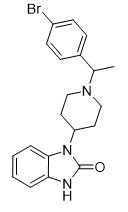 |
| Etodesnitazene | 25 May 2020 | Hamilton, ON | Imported from Poland, seized by CBSA | 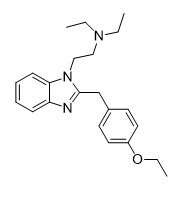 |
| Flunitazene | 9 Dec 2020 | Hamilton, ON | Seized by the police service of Hamilton | 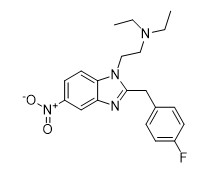 |
| Isotonitazene | 3 May 2019 | Quebec City, QC | Seized by the police service of Quebec City | 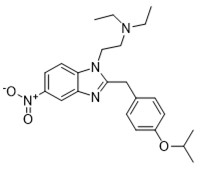 |
| Metonitazene | 21 Aug 2020 | Hamilton, ON | Seized by the police service of Hamilton | 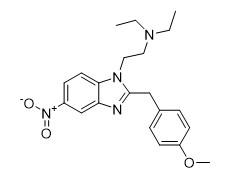 |
| Protonitazene | 30 Dec 2020 | Quebec City, QC | Seized by the police service of Quebec City | 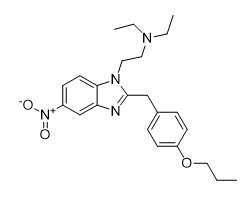 |
Goal and focus
This report aims at presenting the result of a pilot project based on a collaborative work between the DAS, the Canada Border Services Agency (CBSA) and the Royal Canadian Mounted Police (RCMP) related to Nitazenes and Brorphine in order to draw a more complete picture of the situation in Canada.
Methods
Data sources
DAS data
DAS analyzes samples submitted by Canadian law enforcement agencies. All analysis results are entered in a centralized database, the Laboratory Information Management System (LIMS). The presented data covers the period between May 2019 and July 2021, inclusively.
RCMP data
The data presented here were retrieved following identification of exhibits of interest by DAS. Based on this, the research through the RCMP Record Management System was completed for the same period as provided by DAS.
CBSA data
The CBSA laboratory analyzes samples submitted by Border Services Officers from Canadian ports of entry. These samples, which are from imported or exported detained goods that are suspected of being or containing drug substances or precursors, are tracked as cases in a centralized Laboratory Information Management System (LIMS). The presented data is derived from cases that were completed from January 2020 to August 2021, inclusively.
Data extraction
DAS data
The data presented here were retrieved from DAS Laboratory Information Management System (LIMS).
RCMP data
Data extraction was completed manually as the Nitazenes and Brorphine are not currently in the available drop down menu, making these substances not easily searchable. As such, most of the research was completed manually from the RCMP file numbers provided by DAS. In some cases, the research was extended to discussions with investigators as the information on file was insufficient.
CBSA data
The data presented here were retrieved from the CBSA Laboratory Information Management System (LIMS), which was created and is maintained by the CBSA laboratory.
Data analysis
Analysis was performed in R, a data analysis software. Nitazene/Brorphine detections are defined as the identification of a Nitazene/Brorphine in a unique exhibit.
Data limitations
This short report draws on data made available by the Drug Analysis Service (DAS), the Canada Border Services Agency (CBSA) and the Royal Canadian Mounted Police (RCMP).
Sample seized by the Canada Border Services Agency are analyzed in the CBSA Laboratories. This data is only derived from samples submitted for confirmatory analysis at the central CBSA laboratory and may not include all imports or exports of these substances.
Canadian Law enforcement agencies, including the RCMP regularly submit seized exhibits to the DAS Laboratory.
Several limitations govern the data from drug seizures. First, a limited number of samples were analyzed for each substance; low number of samples may not provide an accurate picture of currently circulating substances. Second, since law enforcement agencies submit exhibits for analysis on a voluntary basis, the analyzed samples may not be representative of seized substances. In addition, analyzed samples may not be representative of drug circulating on the market as a number of factors may influence drug seizures and reporting, such as increased awareness of substances and law enforcement capacities and priorities. As such, the data presented here should not be used as a basis for determining trends or making comparisons.
Number and proportion of exhibits analyzed between 2019 and 2021
Between May 2019 and July 2021, there were 615 Nitazene/Brorphine detections in samples analyzed by the DAS and CBSA laboratories in Canada; 577 detections were in samples from police seizures, 27 from RCMP seizures and 11 from CBSA seizures (Table 2). The most frequently detected substance is Isotonitazene followed by Etodesnitazene, representing respectively 46.8% and 32.7% of all the Nitazene/ Brorphine detections. The least frequently detected substance is Flunitazene which was identified once in an exhibit seized in Hamilton, Ontario. While the proportion of Isotonitazene and Etodesnitazene detections decreased in 2021 relative to 2020 the proportion of Protonitazene and Metonitazene detections increased to constitute 25.6% and 18.7% of Nitazene/Brorphine detections in 2021, respectively (Table 2; Figure 2).
Figure 2: Nitazene/Brorphine Detections across time
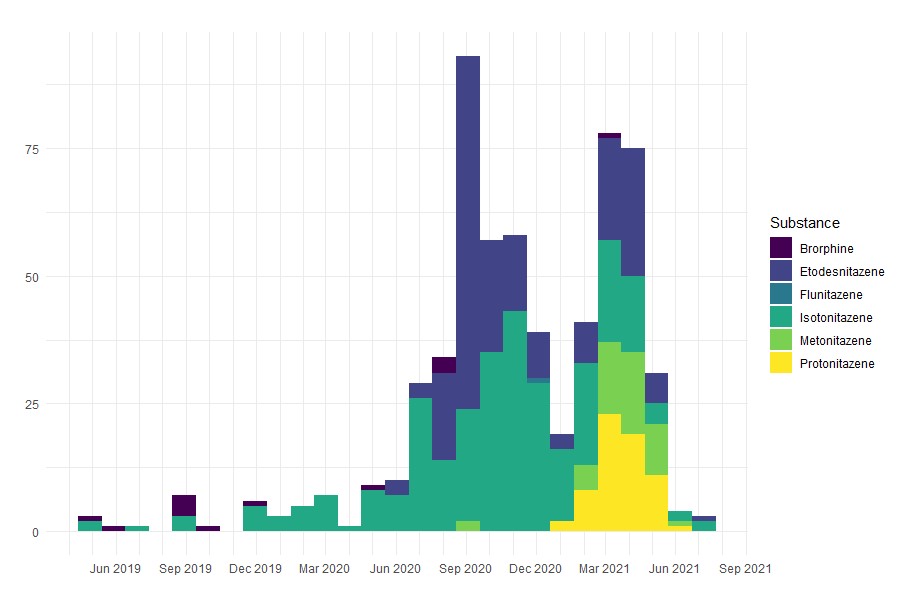
The data presented in this figure is available in Table 2.
| Substance | 2019 | 2020 | 2021 | Total | ||||
|---|---|---|---|---|---|---|---|---|
| n | % | n | % | n | % | n | % | |
| Brorphine | 8 | 40.0 | 4 | 1.1 | 1 | 0.4 | 13 | 2.1 |
| Etodesnitazene | - | - | 138 | 39.5 | 63 | 25.6 | 201 | 32.7 |
| Flunitazene | - | - | 1 | 0.3 | - | - | 1 | 0.2 |
| Isotonitazene | 12 | 60.0 | 203 | 58.2 | 73 | 29.7 | 288 | 46.8 |
| Metonitazene | - | - | 2 | 0.6 | 46 | 18.7 | 48 | 7.8 |
| Protonitazene | - | - | 1 | 0.3 | 63 | 25.6 | 64 | 10.4 |
| Total | 20 | 100 | 349 | 100 | 246 | 100 | 615 | 100 |
Geographic distribution and trafficking routes
The majority of Nitazene/Brorphine detections were in Ontario (43.5%) or Quebec (38.5%) (Table 3). 65.3% of the Isotonitazene detections were from Quebec, 14.6% from Ontario and 6.6% from New Brunswick. By contrast, 87.1% of the Etodesnitazene detections were from Ontario and 10.4% from British Columbia. While Protonitazene was only detected in the east (Quebec, Ontario and New Brunswick), Brorphine was only detected in the west (British Columbia, Alberta and Saskatchewan) (Figure 3). Metonitazene was mainly detected in Ontario (Table 3; Figure 3; Figure 4). This tendency for observing different substances in the Eastern and Western part of the country is not new and reflects enduring differences in the illicit drug market.
Evidence from the CBSA suggest that Isotonitazene is being imported into Canada via airfare from China, Hong Kong and South Korea and that Etodesnitazene is being imported from Poland. Evidence from one seizure only suggested that Isotonitazene has also been found to be exported from Canada to the United States via mail.
Figure 3: Nitazene/Brorphine detections per Province
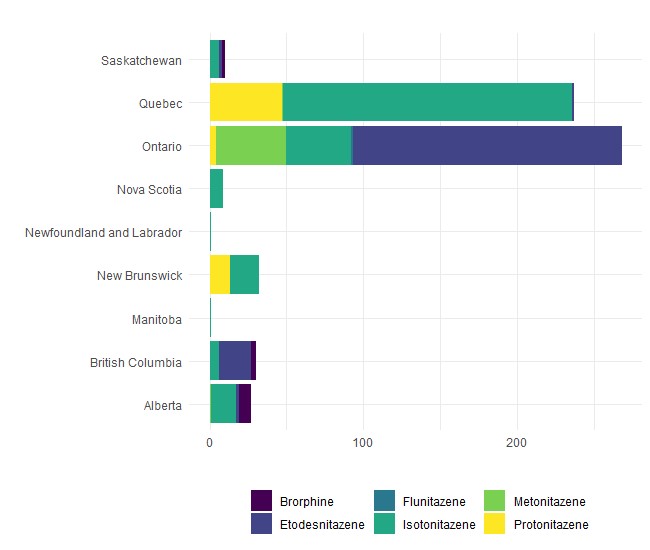
The data presented in this figure is available in Table 3.
| Province | Brorphine | Etodesnitazene | Flunitazene | Isotonitazene | Metonitazene | Protonitazene | ||||||
|---|---|---|---|---|---|---|---|---|---|---|---|---|
| n | % | n | % | n | % | n | % | n | % | n | % | |
| Alberta | 8 | 61.5 | 2 | 1.0 | - | - | 16 | 5.6 | 1 | 2.1 | - | - |
| British Columbia | 3 | 23.1 | 21 | 10.4 | - | - | 6 | 2.1 | - | - | - | - |
| Manitoba | - | - | - | - | - | - | 1 | 0.3 | - | - | - | - |
| New Brunswick | - | - | - | - | - | - | 19 | 6.6 | - | - | 13 | 20.3 |
| Newfoundland & Labrador | - | - | - | - | - | - | 1 | 0.3 | - | - | - | - |
| Nova Scotia | - | - | - | - | - | - | 9 | 3.1 | - | - | - | - |
| Ontario | - | - | 175 | 87.1 | 1 | 100.0 | 42 | 14.6 | 46 | 95.8 | 4 | 6.3 |
| Quebec | - | - | 1 | 0.5 | - | - | 188 | 65.3 | 1 | 2.1 | 47 | 73.4 |
| Saskatchewan | 2 | 15.4 | 2 | 1.0 | - | - | 6 | 2.1 | - | - | - | - |
| Total | 13 | 100 | 201 | 100 | 1 | 100 | 288 | 100 | 48 | 100 | 64 | 100 |
Figure 4: Nitazene/Brorphine detections per Province across time
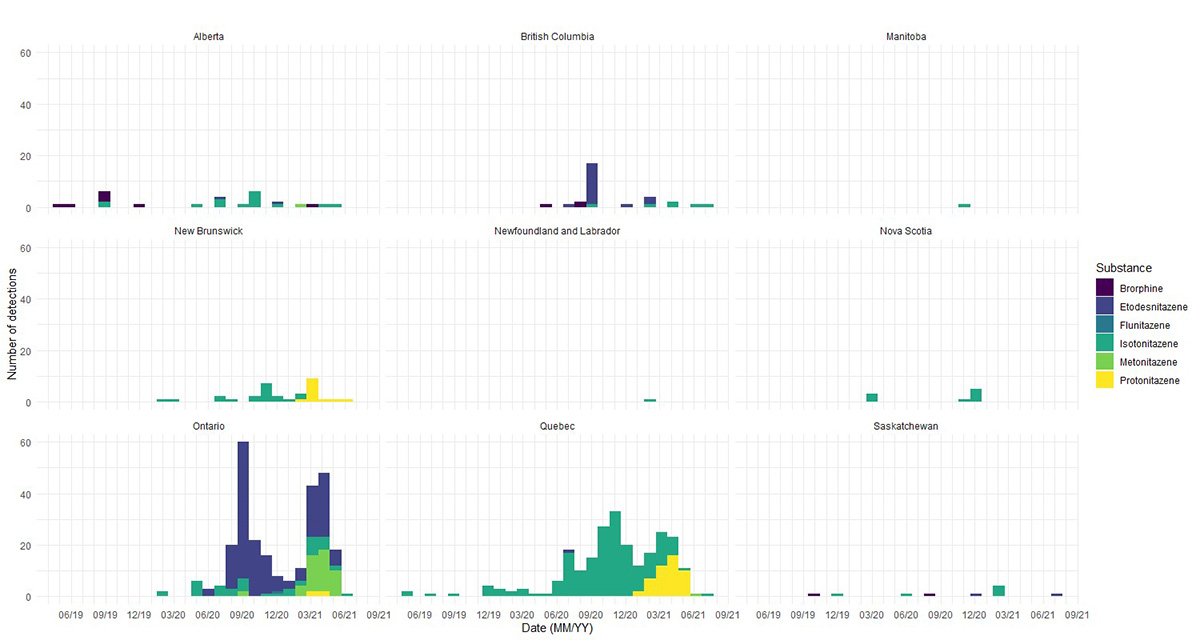
Figure 4 – Text description
| Province | Brorphine n |
Etodesnitazene n |
Flunitazene n |
Isotonitazene n |
Metonitazene n |
Protonitazene n |
||||||||||||
|---|---|---|---|---|---|---|---|---|---|---|---|---|---|---|---|---|---|---|
| 2019 | 2020 | 2021 | 2019 | 2020 | 2021 | 2019 | 2020 | 2021 | 2019 | 2020 | 2021 | 2019 | 2020 | 2021 | 2019 | 2020 | 2021 | |
| Alberta | 7 | - | 1 | - | 2 | - | - | - | - | 2 | 12 | 2 | - | - | 1 | - | - | - |
| British Columbia | - | 3 | - | - | 18 | 3 | - | - | - | - | 1 | 5 | - | - | - | - | - | - |
| Manitoba | - | - | - | - | - | - | - | - | - | - | 1 | - | - | - | - | - | - | - |
| New Brunswick | - | - | - | - | - | - | - | - | - | - | 16 | 3 | - | - | - | - | - | 13 |
| Newfoundland and Labrador | - | - | - | - | - | - | - | - | - | - | - | 1 | - | - | - | - | - | - |
| Nova Scotia | - | - | - | - | - | - | - | - | - | - | 9 | - | - | - | - | - | - | - |
| Ontario | - | - | - | - | 116 | 59 | - | 1 | - | - | 22 | 20 | - | 2 | 44 | - | - | 4 |
| Quebec | - | - | - | - | 1 | - | - | - | - | 9 | 141 | 38 | - | - | 1 | - | 1 | 46 |
| Saskatchewan | 1 | 1 | - | - | 1 | 1 | - | - | - | 1 | 1 | 4 | - | - | - | - | - | - |
| Total | 8 | 4 | 1 | - | 138 | 63 | - | 1 | - | 12 | 203 | 73 | - | 2 | 46 | - | 1 | 63 |
Characteristics of exhibits seized and analyzed
While Brorphine, Etodesnitazene and Metonitazene were mainly detected in powder form, Isotonitazene and Protonitazene were most frequently found in tablet form. Flunitazene was only detected once, in powder form (Figure 5).
Figure 5: Forms of Nitazene/Brorphine detections
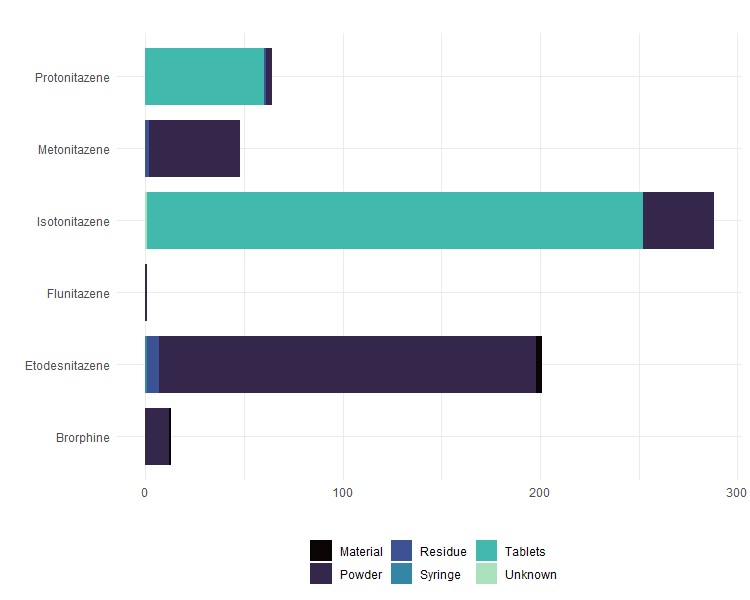
Figure 5 – Text description
| Form | Brorphine | Etodesnitazene | Flunitazene | Isotonitazene | Metonitazene | Protonitazene |
|---|---|---|---|---|---|---|
| n | n | n | n | n | n | |
| Material | 1 | 3 | - | - | - | - |
| Powder | 12 | 191 | 1 | 36 | 46 | 3 |
| Residue | - | 6 | - | - | 2 | 1 |
| Syringe | - | 1 | - | - | - | - |
| Tablets | - | - | - | 251 | - | 60 |
| Total | 13 | 201 | 1 | 287 | 48 | 64 |
Interestingly, while Isotonitazene appeared predominantly in tablet form in the Eastern provinces (Quebec, Ontario, Nova Scotia, New Brunswick, etc.), it was mainly detected in powder form in the Western provinces (Alberta, Saskatchewan and British Columbia) (Figure 6).
The largest seizure of Etodesnitazene was reported in May 2020 at the Hamilton Airport by the Canada Border Service Agency (CBSA) where 500 g was being imported from Poland (Table 4). The largest seizure of Isotonitazene was reported by CBSA in April 2021 in Vancouver International Airport where 500g of the substance was seized as it was being imported from Hong Kong (Table 4). CBSA also intercepted 500g of Isotonitazene at the Pearson International Airport Cargo in April 2021 as it was being imported from South Korea.
| City, Province | Date | Substance | Form | Quantity | Source |
|---|---|---|---|---|---|
| Kelowna, British Columbia | 14 Aug 2020 | Brorphine | Powder | 0.46 g | RCMP |
| Hamilton, Ontario | 25 May 2020 | Etodesnitazene | Powder | 500 g | CBSA |
| Moncton, New Brunswick | 11 Dec 2020 | Isotonitazene | Tablets | 10 tablets | RCMP |
| Vancouver, British Columbia | 22 Apr 2021 | Isotonitazene | Powder | 500 g | CBSA |
| High Prairie, Alberta | 11 Feb 2021 | Metonitazene | Powder | 2 g | RCMP |
Figure 6: Forms of Nitazene/Brorphine detections per Province
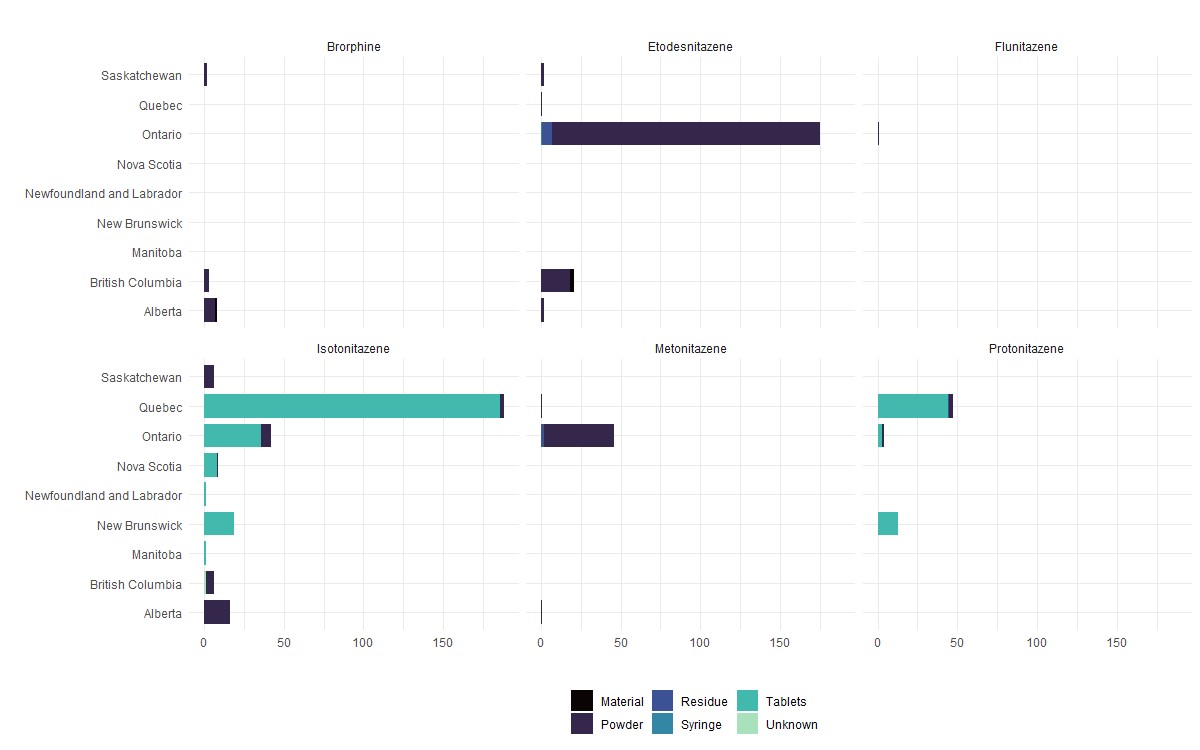
Figure 6 – Text description
| Province | Brorphine n |
Etodesnitazene n |
Flunitazene n |
Isotonitazene n |
Metonitazene n |
Protonitazene n |
|||||||||
|---|---|---|---|---|---|---|---|---|---|---|---|---|---|---|---|
| Material | Powder | Material | Powder | Residue | Syringe | Powder | Unknown | Powder | Tablets | Powder | Residue | Powder | Residue | Tablets | |
| Alberta | 1 | 7 | - | 2 | - | - | - | - | 16 | - | 1 | - | - | - | - |
| British Columbia | - | 3 | 3 | 18 | - | - | - | 1 | 5 | - | - | - | - | - | - |
| Manitoba | - | - | - | - | - | - | - | - | - | 1 | - | - | - | - | - |
| New Brunswick | - | - | - | - | - | - | - | - | - | 19 | - | - | - | - | 13 |
| Newfoundland and Labrador | - | - | - | - | - | - | - | - | - | 1 | - | - | - | - | - |
| Nova Scotia | - | - | - | - | - | - | - | - | 1 | 8 | - | - | - | - | - |
| Ontario | - | - | - | 168 | 6 | 1 | 1 | - | 6 | 36 | 44 | 2 | 1 | - | 3 |
| Quebec | - | - | - | 1 | - | - | - | - | 2 | 186 | 1 | - | 2 | 1 | 44 |
| Saskatchewan | - | 2 | - | 2 | - | - | - | - | 6 | - | - | - | - | - | - |
| Total | 1 | 12 | 3 | 191 | 6 | 1 | 1 | 1 | 36 | 251 | 46 | 2 | 3 | 1 | 60 |
Conclusion
In summary, Isotonitazene is currently the most frequently detected Nitazene/Brorphine in Canada. The number of detections peaked in fall of 2020 with an increase in Etodesnitazene detections, and again in spring of 2021 with increased Protonitazene detections. Protonitazene emerged in late 2020 and constituted a quarter of Nitazene/Brorphine detections in 2021. Detections were most often reported from Ontario and Quebec. The type of substance found as well as their form is regionalised. Continued monitoring is required to ensure partners are aware of the presence of harmful substance on the Canadian market.
Acknowledgements
The development of this fact sheet was made possible through collaboration of Health Canada Drug Analysis Service (HC DAS), the Royal Canadian Mounted Police (RCMP) and the Canada Border Services Agency (CBSA). We wish to thank the members of the Joint HC DAS, RCMP and CBSA Working Group for their contributions in the development of this information product.
A working group report:
Drug Analysis Service – Health Canada:
- Marie-Line Gilbert
- Michèle Boileau-Falardeau
- Cindy Leung-So
Royal Canadian Mounted Police:
- Luc Chicoine
- Michael Bushey
Canada Border Service Agency:
- Vincent Marleau
- Cathy Copeland
- Christian Gagné
- Thomas Berrigan
Suggested Citation
Government of Canada. (2022). Health Canada Drug Analysis Service, Royal Canadian Mounted Police, Canada Border Services Agency. At-A-Glance: The Emergence of Nitazenes and Brorphine in Canada since 2019. Longueuil (QC), 2022. Retrieved from https://www.canada.ca/en/health-canada/services/publications/healthy-living/emergence-nitazenes-brorphine-canada-2019.html
References
- Footnote 1
-
Center for Forensic Science Research & Education. (n.d.). 2021 Q1 NPS Opioids Trend Report. Retrieved August 11, 2021, from https://www.npsdiscovery.org/wp-content/uploads/2021/04/2021-Q1_NPS-Opioids_Trend-Report.pdf
- Footnote 2
-
United Nations Office on Drugs and Crime. (n.d.). Global SMART 2020: the growing complexity of the opioid crisis. Retrieved August 11, 2021, from https://www.unodc.org/documents/scientific/Global_SMART_Update_2020-Vol.24-Eng-Final.pdf
